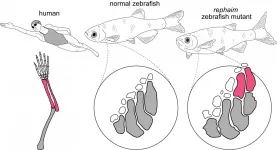(Press-News.org) Fin-to-limb transition is an icon of key evolutionary transformations. Many studies focus on understanding the evolution of the simple fin into a complicated limb skeleton by examining the fossil record. In a paper published February 4 in Cell, researchers at Harvard and Boston Children's Hospital examined what's occurring at the genetic level to drive different patterns in the fin skeleton versus the limb skeleton.
Researchers, led by M. Brent Hawkins, a recent doctoral recipient in the Department of Organismic and Evolutionary Biology, performed forward genetic screens in zebrafish looking for mutations that affect the fin skeleton. Unlike tetrapod limbs, which have complex skeletons with many bones that articulate at many joints, zebrafish pectoral fins have a simple endoskeleton that lacks joints. To their surprise, Hawkins and colleagues found mutants that modified their fins into a more limb-like pattern by adding new bones, complete with muscles and joints. These results reveal that the ability to form limb-like structures was present in the common ancestor of tetrapods and teleost fishes and has been retained in a latent state which can be activated by genetic changes.
"We look at some of the developmental aberrations and ask, can they inform us of the processes that were happening underlying some of these large shifts in evolution," said senior author Matthew P. Harris, Associate Professor of Genetics at Harvard Medical School and Orthopedic Research at Boston Children's Hospital. "And when you see something that shouldn't be there, ever, I mean 400 million years type of never, it's a major finding."
Zebrafish belong to the teleost lineage of ray-finned fishes. Teleosts are a diverse lineage of about 30,000 species that includes goldfish, salmon, eels, flounder, clownfish, pufferfish, catfish and zebrafish. There are more teleost species than all birds, mammals, reptiles, and amphibian species combined. Yet, despite the large number of species and wide ranges of shapes, sizes, and habitats, the pectoral fin of teleosts is surprisingly simple and unchanged.
The fin-to-limb transition in the tetrapod lineage modified and elaborated the ancestral fin to include many bones that articulate end on end. From the same ancestral starting state, teleost fins were reduced and simplified, such that there is no end-on-end articulation, only the side-by-side arrangement of the proximal radials. This structure allowed researchers to determine which aspects of development are uniquely limb and which features are common across teleost and tetrapod fins and limbs.
Study co-author Katrin Henke, Boston Children's Hospital, performed forward genetic screens to mutate DNA at random and identify genes that control the formation of the fin skeleton. When a mutation caused interesting changes to the zebrafish skeleton, researchers then worked backwards to genetically map the mutation and determine which genes were affected. In this case, they discovered that mutations in the waslb and vav2 genes cause the fin phenotype. This was a surprising finding as these genes have not previously been known to play roles in patterning the body.
"It was a big question as to how waslb and vav2 were changing fin patterning," said Hawkins. "These genes were not known to interact with any of the very well characterized pathways that guide limb development. However, we found that these mutations cause an increase in the expression of the gene hoxa11b. This gene is very exciting because the Hox genes are in part responsible for patterning the vertebral column as well as the regions of the limb. And the Hox11 genes in particular are required to make the forearm."
The researchers used an advanced CRISPR knock-in approach and inserted a marker into the genome that shows where a particular gene is active. They replaced the hoxa11b gene with a red fluorescent protein, and cells that express hoxa11b glow red. This tool allowed them to determine that the mutants increase the expression of hoxa11b to form the new bones.
Histological analysis revealed that the new bones had muscle attachment, which occurs extensively in limb bones, but not in the fin. In teleost fishes there are no muscles attached to the bones. Instead, the bones provide an intermediate support in the fin and the muscles extend directly from the shoulder out to the bony fin rays, bypassing the bones all together. The new bones are fully integrated into the fin, complete with joints for articulation and attachment to the fin muscles.
Much work has been done in the field of limb development and it provides a good understanding of what genes are present and required to make the limb form. In this study however, researchers flipped traditional approaches by focusing on the small simple zebrafish fin and asking what genetic changes could elaborate the appendage and increase its complexity. "Prior to this there aren't any examples where we have genes or mutations that actually elaborate the structure and make it even more complicated," said Hawkins. "Even in the case of limbs we only know how to make a limb smaller or less complex, but we didn't have any information on how add elements to a fin or a limb."
"That was very surprising as well," confirmed Harris. "We had no hard experimental examples where you take a gene, turn it up, make it work more and get a more complex mature structure at the end. In our findings we actually found some of the dials that can turn up the genetic pathways and get a more complicated structure in the end."
Previously, other researchers removed the Hox11 genes in mice and found this prevented the radius and ulna from fully forming. "Given that both the new bones in our mutant and the forearm of the limb are located in the middle part of the appendage, our result suggests that fins and limbs both use Hox11 cues to specify this region," stated Hawkins.
This finding also fits well with another recent discovery that Hox13 genes are required to form the distal regions of both fins and limbs. Altogether these discoveries reveal that the appendage Hox code was likely present in the common ancestor of tetrapods and teleost fishes and is not specific to the tetrapod lineage.
This study shows that both fins and limbs use the same genetic mechanisms to specify the middle portion of the appendage. Going forward, Hawkins hopes to explore the question, do fins and limbs make other appendage regions in the same way?
"There's still the humerus in the limb and we don't know what the corresponding part in the fin is for that, in terms of the genetic requirements," said Hawkins. "We know there are proximal cues that determine where the humerus should go, but we don't know if the fish use these cues or not. We want to know in a developmental sense how those cues arose in limbs and if those cues are present in some form in the fish fin already. And hopefully we can fill out the correspondence between fins and limbs."
INFORMATION:
Article and author details
M. Brent Hawkins, Katrin Henke, Matthew P. Harris. 2021. Latent developmental potential to form limb-like skeletal structures in zebrafish. Cell DOI 10.1016/j.cell.2021.01.003.
Although scientists knew that some bats could reach heights of over 1,600 meters (or approximately one mile) above the ground during flight, they didn't understand how they managed to do it without the benefit of thermals that aren't typically available to them during their nighttime forays. Now, researchers reporting in the journal Current Biology on February 4th have uncovered the bats' secret to high-flying.
It turns out that the European free-tailed bats they studied--powerful fliers that the researchers documented sometimes reaching speeds of up to 135 kilometers (84 miles) per hour in self-powered flight--do depend on orographic uplift that ...
As the planet warms, glaciers are retreating and causing changes in the world's mountain water systems. For the first time, scientists at the University of Oxford and the University of Washington have directly linked human-induced climate change to the risk of flooding from a glacial lake known as one of the world's greatest flood risks.
The study examined the case of Lake Palcacocha in the Peruvian Andes, which could cause flooding with devastating consequences for 120,000 residents in the city of Huaraz. The paper, published Feb. 4 in Nature Geoscience, provides new evidence for an ongoing legal case that hinges on the link between greenhouse gas emissions and particular climate change impacts.
"The scientific challenge was to provide the clearest and cleanest assessment ...
CHICAGO - A new study by Northwestern University researchers finds involvement with firearms by high-risk youth is associated with firearm violence during adulthood.
"Association of Firearm Access, Use, and Victimization During Adolescence with Firearm Perpetration During Adulthood in a 16-year Longitudinal Study of Youth Involved in the Juvenile Justice System" will publish in JAMA Network Open at 10 a.m. CST, Thursday, Feb. 4. Access the full study online.
The longitudinal study of juvenile justice youth is the first to analyze firearm victimization and access during adolescence and its association with firearm violence in adulthood.
The study is based ...
Toronto - (February 4, 2021) The results of a Phase III randomized clinical trial have shown that when it comes to detecting clinically significant prostate cancer, Magnetic Resonance Imaging (MRI) with targeted biopsies (MRI-TBx) matches the current standard and brings a multitude of advantages. The PRostate Evaluation for Clinically Important Disease: MRI vs Standard Evaluation Procedures (PRECISE) study will help to make prostate cancer diagnosis more accurate and less invasive.
PRECISE included 453 participants at Canadian academic cancer centres who were either assigned to receive MRI ...
What The Study Did: Researchers estimated the rate of nurse burnout in the United States and the factors associated with leaving or considering leaving their jobs due to burnout.
Authors: Megha K. Shah, M.D., M.Sc., of the Emory University School of Medicine in Atlanta, is the corresponding author.
To access the embargoed study: Visit our For The Media website at this link https://media.jamanetwork.com/
(doi:10.1001/jamanetworkopen.2020.36469)
Editor's Note: The article includes conflict of interest and funding/support disclosures. Please see the article for additional information, ...
What The Study Did: Researchers in this randomized clinical trial investigated whether nasopharyngeal application of povidone iodine could reduce the viral load of patients with nonsevere COVID-19 symptoms.
Authors: Olivier Mimoz, M.D., Ph.D., University Hospital of Poitiers in Poitiers, France, is the corresponding author.
To access the embargoed study: Visit our For The Media website at this link https://media.jamanetwork.com/
(doi:10.1001/jamaoto.2020.5490)
Editor's Note: The article includes conflict of interest and funding/support disclosures. Please see the article for additional information, including other authors, author contributions and affiliations, conflict of interest and financial disclosures, ...
What The Study Did: This randomized clinical trial looked at changes in levels of the hormone estradiol in men with hormone receptor-positive breast cancer after three months of treatment with endocrine therapies.
Authors: Sibylle Loibl, M.D., Ph.D., of the German Breast Group in Neu-Isenburg, Germany, is the corresponding author.
To access the embargoed study: Visit our For The Media website at this link https://media.jamanetwork.com/
(doi:10.1001/jamaoncol.2020.7442)
Editor's Note: The article includes conflicts of interest and funding/support disclosures. Please see the article ...
CAMBRIDGE, MA -- Cryo-electron microscopy (cryo-EM) allows scientists to produce high-resolution, three-dimensional images of tiny molecules such as proteins. This technique works best for imaging proteins that exist in only one conformation, but MIT researchers have now developed a machine-learning algorithm that helps them identify multiple possible structures that a protein can take.
Unlike AI techniques that aim to predict protein structure from sequence data alone, protein structure can also be experimentally determined using cryo-EM, which produces hundreds of thousands, or even millions, of two-dimensional images of protein samples frozen in a thin layer of ice. Computer algorithms then piece together these images, taken from different angles, into a three-dimensional ...
The next time you tuck in to a tikka masala you might find yourself asking a burning question: are spices used in dishes to help stop infection?
It's a question many have chewed the fat over. And now thanks to new research from The Australian National University (ANU) we have an answer.
The quick takeaway is: probably not.
Professor Lindell Bromham and her colleagues asked why hot countries across the world tend to have spicy food? This pattern has led to what some have termed "Darwinian gastronomy" - a tummy-led cultural evolutionary process in countries with hotter climates.
To find out the answer to their question, the researchers feasted on a true ...
You might remember you ate cereal for breakfast but forget the color of the bowl. Or recall watching your partner put the milk away but can't remember on which shelf.
A new Northwestern Medicine study improved memory of complex, realistic events similar to these by applying transcranial magnetic stimulation (TMS) to the brain network responsible for memory. The authors then had participants watch videos of realistic activities to measure how memory works during everyday tasks. The findings prove it is possible to measure and manipulate realistic types of memory.
"On a day-to-day basis we must remember complex events that involve many elements, such as different locations, people and objects," said lead author Melissa Hebscher, a postdoctoral fellow ...


